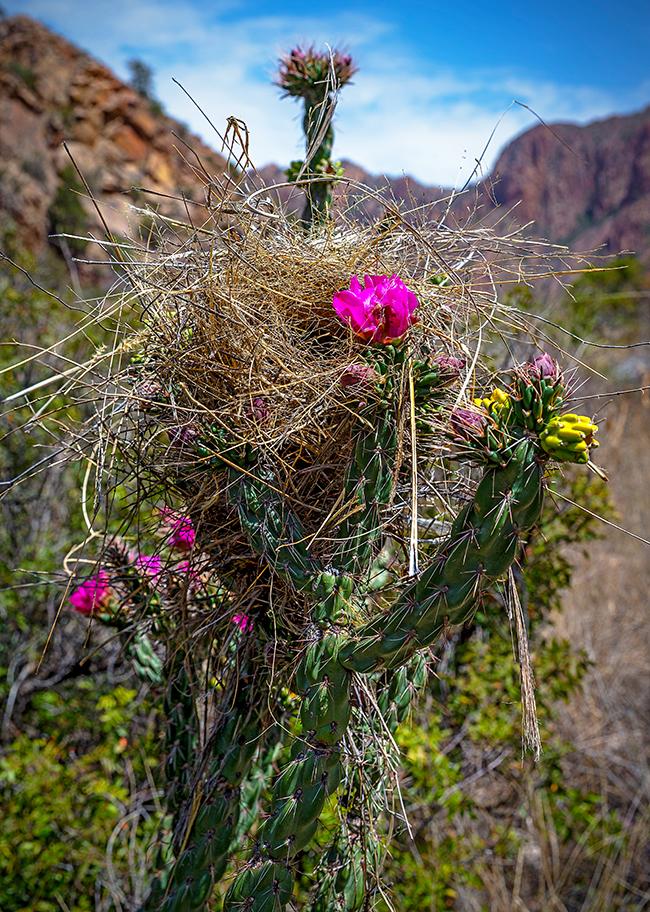Big Bend National Park is home to 11 species of amphibians, 56 species of reptiles, 40 species of fish, 75 species of mammals (including 22 species of bats), more than 450 species of birds, and about 3,600 species of insects. Not only that, but this national park hosts more types of birds, bats, butterflies, ants, and scorpions than any other national park in the United States!
Surely, with those numbers, you’ll spot some wildlife during your trail explorations, right? It’s almost a given you spot squirrels and deer and probably a Mexican jay or two. Anywhere with a body of water (river, pond) will attract javalinas (they look like pigs but they are not), skunks, and raccoons. You might see the javalina during the day, but you’ll have to be out in the evening or at night to look for the other two mentioned, since they are nocturnal. Dugout Wells and Sam Nail Ranch are two such oases where you might spot these animals.

Vinegaroon, Big Bend National Park / NPS - C.A. Hoyt
Hiking around rocky areas like that last half mile or so along the Window Trail, it’s possible you’ll spy a ringtail, lizard, rattlesnake, scorpion, or an odd, scorpion-like arachnid with a whip for a tail instead of the stinger called a vinegaroon (aka whip scorpion). When threatened, their tails will spray a mist consisting of 85 percent acetic acid (vinegar, hence the name vinegaroon). Scorpions and vinegaroons are nocturnal, so you probably won’t see them during your day hike. Still, watch where you place your hands and feet while maneuvering around rocky areas like the last half mile or so along the Window Trail.
You might see a tarantula crossing the road (to get to the other side, haha). Usually, these solitary spiders keep to themselves in their burrows, but when it’s mating season, the males will look for a female with which to go a-courtin’. Sometimes, that involves crossing the park roads. Please don’t run over them! Instead, take out your camera with its telephoto lens or telephoto setting and grab a few shots.

Texas brown tarantula, Big Bend National Park / Rebecca Latson
Black bears and bobcats roam the Big Bend area. Bobcats are Big Bend’s most numerous and commonly seen cats, living and roaming through brushy areas throughout the park and not often seen during the day. According to park staff, sometimes you’ll see bobcats around the Rio Grande Village campground and picnic areas.

Bobcats, Big Bend National Park / NPS - C.A. Hoyt
Black bears were quite common in the early 1900s, but by 1944, they were practically wiped out by hunters, ranchers, and trappers, as well as loss of habitat. They’ve made a comeback, and today, visitors regularly see them in the Chisos Mountains. If you happen to see a black bear, here is what you should do.

A black bear up in a madrone tree, Big Bend National Park / NPS - Reine Wonite
Mentioned earlier, 22 species of bats call Big Bend their home. They inhabit all three ecosystems (desert, mountain, river) and are diverse in terms of feeding habits and roosting spots. Of these species, the most common are the western pipistrelle, pallid bat, Townsend’s big-eared bat, and Brazilian free-tailed bat.
You are definitely going to see (and hear) one or more of the 450 species of birds living or flying through Big Bend. Hike along the Lost Mine Trail and you might see a Mexican Jay.

Mexican jay, Big Bend National Park / Rebecca Latson
Stand in the patio portion of the Chisos Mountain Lodge’s restaurant and you might spot a Say’s phoebe.

Say's phoebe fledglings, Big Bend National Park / Rebecca Latson
Perhaps you’ll see a shrike (aka butcherbird) perched on a thorny bush or in a tree. The black “mask” across their eyes makes them look like bandits. Although they are cute birds, shrikes are a bit on the viscious side, impaling their prey on thorns, barbed wire, and anything else with a pointy end to save for a later meal.

Shrike, Big Bend National Park / Rebecca Latson
Look toward the tops of yucca, sotol, or cactus and you might chance upon a little cactus wren fluffing its feathers against a chill breeze.

Cactus wren fluffing its feathers on a chilly breezy day, Big Bend National Park / Rebecca Latson
As you wander the Chisos Basin parking area, perhaps you’ll meet up with the resident roadrunner either looking for a handout (please don’t feed them) or hiding from Wile E. Coyote. Meep meep!

The resident road runner, Big Bend National Park / Rebecca Latson
While hiking up into the mountains during the springtime, you might come across birders looking for the Colima warbler. This Mexican species occurs only in Big Bend National Park, where it is common, even though but you might have to spend an entire day up in the Chisos Mountains looking for it, since this bird likes those cooler high elevations in the summer. Look for the Colima warbler in the lower levels of oak trees.
Even if you don't see a bird, you'll still find evidence of them. There are nests in the cactus as well as the trees. You'll be able to spot those nests more clearly during a winter visit, when those trees are devoid of their leaves.

A bird's nest in the cholla cactus, Big Bend National Park / Rebecca Latson





